我发现了两种主要方法来查看点是否属于多边形内。一种是使用此处使用的光线跟踪方法,这是最推荐的答案,另一种是使用matplotlib path.contains_points(对我来说似乎有点晦涩)。我将不得不不断检查很多要点。有人知道这两个中的任何一个是否比另一个更可取,或者是否有更好的第三种选择?
更新:
我检查了这两种方法,matplotlib看起来更快。
from time import time
import numpy as np
import matplotlib.path as mpltPath
# regular polygon for testing
lenpoly = 100
polygon = [[np.sin(x)+0.5,np.cos(x)+0.5] for x in np.linspace(0,2*np.pi,lenpoly)[:-1]]
# random points set of points to test
N = 10000
points = zip(np.random.random(N),np.random.random(N))
# Ray tracing
def ray_tracing_method(x,y,poly):
n = len(poly)
inside = False
p1x,p1y = poly[0]
for i in range(n+1):
p2x,p2y = poly[i % n]
if y > min(p1y,p2y):
if y <= max(p1y,p2y):
if x <= max(p1x,p2x):
if p1y != p2y:
xints = (y-p1y)*(p2x-p1x)/(p2y-p1y)+p1x
if p1x == p2x or x <= xints:
inside = not inside
p1x,p1y = p2x,p2y
return inside
start_time = time()
inside1 = [ray_tracing_method(point[0], point[1], polygon) for point in points]
print "Ray Tracing Elapsed time: " + str(time()-start_time)
# Matplotlib mplPath
start_time = time()
path = mpltPath.Path(polygon)
inside2 = path.contains_points(points)
print "Matplotlib contains_points Elapsed time: " + str(time()-start_time)
这使,
Ray Tracing Elapsed time: 0.441395998001
Matplotlib contains_points Elapsed time: 0.00994491577148
使用三角形而不是100个边的多边形获得了相同的相对差。我也会仔细检查一下,因为它看起来像是专门针对这些问题的软件包
